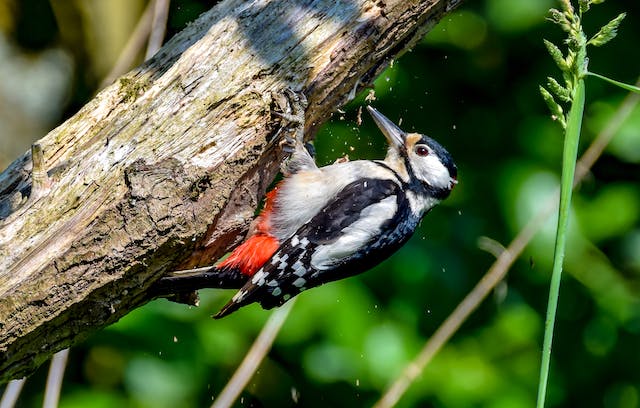
Why do woodpeckers peck wood? They are trying to find food, mark their territory, find a mate, or make a nest.
There are 240 different species of woodpecker, and they live in most countries except for Australasia, Madagascar, and Antarctica. Other than their pecking and the adaptations they have to enable it, they are normal birds. Some species migrate and some don’t. Some species are very small, and some can be 50 cm tall. Some species fly fairly slowly, and some can fly at nearly 100 km/h.
So, why do woodpeckers peck wood? The first reason is to find food. Woodpeckers eat insects that live under the bark of trees. They also eat ants, termites, caterpillars, beetles, larvae, eggs, and almost anything they can get. The birds don’t just randomly peck on the tree, they listen first to work out where the insects are. Then they peck a hole through the bark. They might not be able to reach the insect with their beaks, but they have incredibly long, barbed tongues that they can use to pull the insects out. The tongue has nine bones in it and when it is withdrawn, it is so long that it wraps around the inside of the woodpecker’s skull. It looks like woodpeckers are damaging the trees, but they quite often catch insects that eat the trees from under the bark, such as carpenter ants and wood-boring beetles. They protect the trees from this disease and infection, and they only remove the outer layer of bark, which the tree can replace. They generally do more good than they do harm, although they can occasionally be a problem for the tree. Sometimes insects or diseases get into the tree through holes the woodpecker has made. A tree’s bark is its first line of defense against pests and removing this can be harmful. Another way a woodpecker can harm a tree is if there is an infestation of insects and the woodpecker pecks all around the tree to get them. This can remove a strip of bark right around the tree, called girdling, and it can stop the tree transporting water and nutrients.
The second reason they peck on trees is to mark their territory and to find a mate. The sound they make is very loud and it carries for a long distance. Woodpeckers can alternate the speed, length, rhythm, and even the tone of their pecking to signal where they are. Each species has a different type of pecking sound and individual birds can also vary their sound. This lets other woodpeckers know that they are in the area and to stay away. It also lets female woodpeckers know where the males are.
The third reason they peck on trees is to make a nest. Woodpeckers usually nest in the holes they have made in trees. They line the edge with moss and leaves to disguise it and nest inside.
How can woodpeckers peck through the bark of a tree? They have several adaptations which let them do it. First, their feet are shaped differently to other birds. Most birds have three twos in front and one pointing backwards for balance and grip. A woodpecker has two toes pointing forward and two pointing backwards, which lets them grip the tree vertically and balance while they peck. They also have very stiff tail feathers which they can brace against the tree to give them even more stability.
If you or I banged our head against a tree, we wouldn’t be able to repeat it many times before we did ourselves serious injury. A woodpecker can peck on a tree up to 20 times a second, experiencing phenomenal G-force that would kill any other animal. Their speed is down to the tendon at the back of their neck and under the jaw. Tendons can store and release energy, almost like a spring, and don’t require as much energy as a muscle would need. This explains their speed but not how they avoid brain damage. Their beak is the first line of defense. The lower half of the beak is longer than the upper half, which directs the impact energy down into the body and away from the brain. The beak is also shaped like a chisel so it slices in rather than hammers, reducing impact. Then the skull is a matrix of bone with lots of spaces. This makes it very strong, very light, and able to compress slightly, so it doesn’t shatter with the impact energy. The tongue is another adaptation. The long tongue they use to catch insects wraps around the inside of the skull and acts as a shock absorber and a frame to hold the brain still. Then, finally, they have stiff feathers over their nostrils so that they don’t inhale any of the wood dust.
All of these adaptations are to avoid brain damage, but a recent study actually looked at if it works. In humans, brain damage and Alzheimer’s disease are quite often associated with a build up of a protein in the brain called tau. Healthy brains clean out this protein and it builds up in unhealthy brains. The researchers discovered that woodpeckers have far more tau protein in their brains than other birds did. Perhaps they have evolved to keep functioning with this buildup. Or perhaps it protects their brains in some way. Hopefully, researchers can learn about this, and it might help us with diseases like Alzheimer’s. And this is what I learned today.
Photo by John Napier : https://www.pexels.com/photo/black-and-white-bird-on-brown-tree-branch-10286262/
Sources
https://en.wikipedia.org/wiki/Woodpecker
https://www.fieldmuseum.org/blog/what-woodpecker-brains-can-tell-us-about-concussions
https://phoenix.aaacwildliferemoval.com/blog/woodpeckers/do-woodpeckers-damage-trees/
